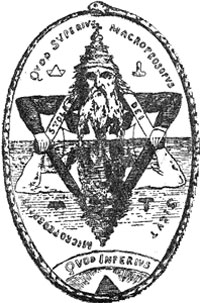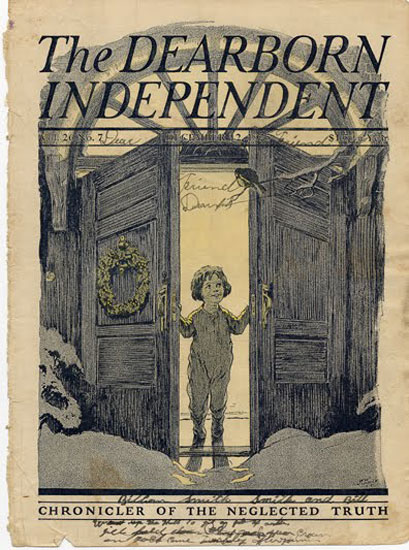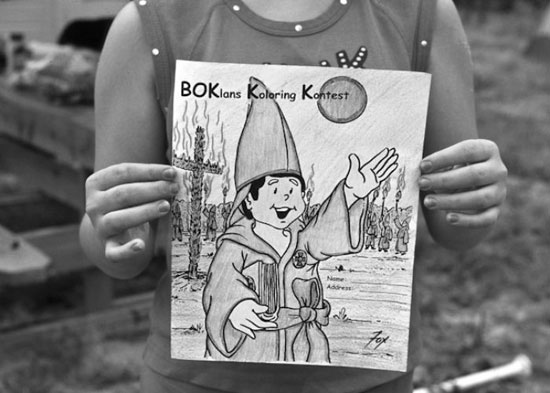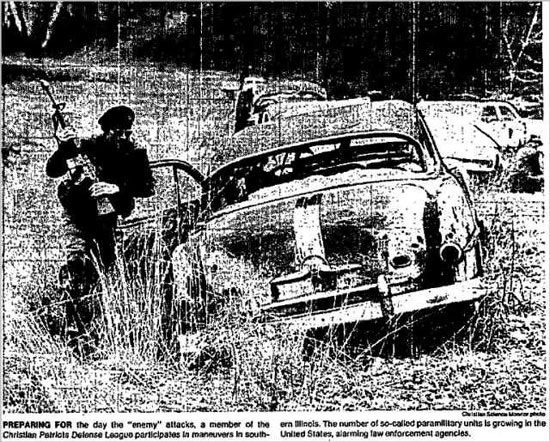Conspiracy TheoryModern conspiracy theory traces its roots to the French cleric Abbé Barruel. In 1797 Barruel wrote an account of the French Revolution focused on the Jacobins. Behind the Jacobins he saw a conspiracy of three secret societies: the Order of Templars, the Order of Freemasons and the Illuminatti.2 In 1806 the retired army officer J.B. Simonini praised Barruel’s analysis in a letter to him, but pointed out “the omission” that Jews had founded both the Freemasons and the Illuminatti for world domination.3 In his book
Proofs of a Conspiracy Against All the Religions and Governments of Europe, the Scotsman John Robison further argued, “Nothing is more clear than that the design of the Illuminatti was to abolish Christianity.”4 Many in the United States, clergymen especially, greeted the French Revolution with suspicion. In May 1798 the Reverend Jedidiah Morse warned of a Jacobin-derived plot against American political and religious institutions. Soon after, journalists exposed the Robison book as fraudulent. By the end of 1799 the Illuminatti affair was, for the time being, over.5
Around 1891 the novel Biarritz, written by Prussian postal worker Hermann Goedsche under the pen name Sir John Retcliffe, gained notoriety throughout Europe. What captivated many of its readers was a sensationalistic chapter entitled “In the Jewish Cemetery in Prague.” In it, elders from the twelve tribes of Israel gather at the grave of the most venerable rabbi and discuss the progress of their plot to take over the world. This text was reprinted as a pamphlet called “The Rabbi’s Speech” and distributed throughout Russia and France. In time, readers came to accept this story as fact and it became the basis for the
Protocols of the Elders of Zion. The
Protocols purport to be a transcript of lectures given by leading Jews at a 1840 world congress in Cracow, Poland.6 They were pieced together between 1872 and 1895 from various sources: the writings of Barruel, Simonini, Goedsche plus books by Maurice Joly and Gougenot des Mousseax. 7 James Ridgeway has summarized them as follows:
The Protocols argue that people are incapable of governing themselves, and only a despot using armed force can govern effectively….[The Jews have plotted their] rise to power by pitting the Gentiles against one another until, eventually…[they] will be able to enlist the masses in overthrowing their indolent gentile leaders. Thereafter the masses will be kept under firm control through an efficient government that will banish unemployment, apply taxation in proportion to wealth, and promote education. During this messianic age the Jewish masters will shrewdly promise, but never deliver, liberty.8
Although London Times correspondent Philip Graves showed parts of the Joly’s book had been plagiarized in the Protocols, they too became accepted as fact. Shortly before the October Revolution, the czar’s secret police published another version in an attempt to smear its opponents.9
 The Jew Bolshevic Emblem surrounded by the
The Jew Bolshevic Emblem surrounded by the
Symbolic Serpent in the Protocol book.In the 1920s Henry Ford widely distributed the Protocols in the United States. His weekly newspaper, the Dearborn Independent, included them as part of a series on “the Jewish international conspiracy.” According to the Independent, Jewish influence was everywhere. Jews forced William Howard Taft to break a commercial treaty with Russia (thereby weakening the czar). They controlled Woodrow Wilson’s administration, particularly through Bernard Baruch, chair of the War Industries Board. (Wilson initiated the League of Nations, forerunner to the far right’s much hated United Nations.) Communism itself was a Jewish plot. The Independent also charged that Paul Warburg intended to control the US financial system with the Federal Reserve. Ford later anthologized the entire series as The International Jew and distributed the book worldwide. Half a million copies circulated in the US alone. In Germany, it became a cornerstone of fascist propaganda. In 1927 Aaron Sapiro sued the Independent for libel in its series “Jewish Exploitation of Farmer Organizations.” Although the lawsuit ended in a mistrial, Ford closed the newspaper.10 During this highly publicized case, the Independent’s editor, William J. Cameron, took full blame for the newspaper’s policies. Wilson and the Warburg family also challenged Ford’s accusations. Ford retracted them, claiming his employees had published the material without his consent. Yet, in 1938, Ford accepted the Grand Cross of the German Eagle, becoming the first American to be decorated with that medal.11 Christian Identity expert Michael Barkun has noted the irony of Ford’s anti-Semitism:
The so-called “pseudo-agrarian” movements…beginning in the 1890s…sought to blame rural and small-town social dislocations on an urban, plutocratic conspiracy. More often than not, this cabal was identified as explicitly Jewish, and it became a convenient scapegoat for those troubled by departures from traditional social values. It was ironical that Henry Ford, himself an agent of some of these changes…became…one of the principal voices for an anti-Semitic politics of resentment.12
In the 1930s a new religious revival swept across the US, reviving, among other things, the anti-Semitism Ford had espoused earlier on. Just as a convulsive modernization left Germany open to Nazism, so economic turmoil and rapid urbanization drove many Americans to fundamentalist religion. With fire and brimstone preachers grimly warning of the coming apocalypse, paranoia and racism were overlaid on these beliefs. Three figures dominated the fundamentalist movement: Gerald B. Winrod, William Pelley and Gerald K. Smith.13
 The Dearborn Independent newspaper printed by Henry Ford, 1925.
The Dearborn Independent newspaper printed by Henry Ford, 1925.Gerald B. Winrod preached that Christ would soon return for the Battle of Armageddon. He believed that while anti-Semitism is founded in Biblical prophecies, only a “certain element” of world Jewry advocates subversion. The widow of Christian Identity minister Wesley Swift believes that it was Winrod who introduced her husband to British-Israelism, the paradoxical forerunner to the Identity movement that first identified with Jews, then turned anti-Semitic.14 What distinguished Winrod from other preachers was his 1938 bid for US Senate in Kansas. He finished third in the Republican primary elections with considerable support from Mennonite communities and the Ku Klux Klan.15
At the outset of his career, William Pelley had been a supporter of Woodrow Wilson and the League of Nations. In 1927, he underwent a sudden mystical transformation, withdrawing from society and experiencing a “rebirth” during which he claimed to have heard voices from other worlds. He came back to public life believing in reincarnation—particularly in the reappearance of “demon souls” as Jews. Later, Pelley embraced the work of “pyramidologist” David Davidson, who was a follower of British Israelism. By integrating Davidson’s work with anti-Semitism, Pelley helped lay the groundwork for Christian Identity. 16 After Hitler came to power in Germany, Pelley founded the Silver Legion—or Silver Shirts as Pelley sometimes called them, after the Brown Shirts. Pelley even claimed that Christ himself had accepted his offer to become an honorary Silver Shirt. In 1942, trying to quash nativist reactionaries, the Roosevelt administration charged both Pelley and Winrod with sedition. Pelley spent fifteen years in prison.17
Like Winrod, Gerald K. Smith was a fundamentalist who entered politics. In 1933 he joined Pelley’s Silver Shirts, then went on to help manage Huey Long’s presidential campaign. After Long’s assassination in 1935, Smith unsuccessfully ran for office himself. He then formed the Union Party with Father Charles Coughlin and Francis Townsend. The Union Party ran William Lemke against Roosevelt in the 1936 election, but received less than a million votes. Smith next moved to Detroit and met Henry Ford who sponsored his radio broadcasts and furnished him with investigators for compiling the “Ford Company Red File,” a list of known or suspected communists. This work inspired feverish visions of Jewish conspiracy in Smith’s mind. He proclaimed, “Communism is Jewish” and speculated that Roosevelt never died, but that Jews had hidden him to later bring him back as “President of the World.” Even after the Second World War, Smith maintained that people had misunderstood Hitler and that the holocaust was a hoax. Despite his bizarre speculations, Smith was a commanding speaker who could rally large audiences. During the Second World War he met with Christian Identity theologian Wesley Swift and converted to the obscure sect that now provides a religious and ideological foundation for many recent hate groups.18 As an agitator, Smith helped politicize the Identity movement; using key Identity figures to forward his own political agenda, he lent coherence to an otherwise fragmented movement.19
Kenneth Goff, a Christian Identity minister and protegé of Minuteman founder Robert DePugh, claims the conspirators have continued to control international politics even today. According to him, Benito Mussolini, Nikolai Lenin and Colonel E. Mandel House (a chief aide to Wilson) laid the plans for the First World War at a conference in Belgium during the early 1900s. After House convinced Czar Nicholas II to abdicate his throne, Jacob Schiff, through the financial firm of Kuhn, Loeb & Co., engineered Lenin’s rise to power. To cover their tracks, Zionists launched a “disinformation campaign” portraying their allies, the Russian Communists, as anti-Semitic. Goff claims that the international Jewish banking cabal further consolidated its hold on the world economy through marriages between the Loeb, Rothschild and Warburg families. To win sympathy, they fabricated accounts of the holocaust in Nazi Germany and continue to use the charge “anti-Semitic” to disable their critics. The “Jewish” agent Alger Hiss, served on the US delegation to the Yalta Conference and helped arrange to grant the Soviet Union veto power in the United Nations.20 From Goff’s perspective, a secret cabal controls mainstream television, radio and newspapers as well: the so-called “Jews’ media.” Those who subscribe to anti-Semitic conspiracy theories have come to call the Federal government the Zionist Occupation Government—or ZOG, for short.
In 1991, Pat Robertson’s book The New World Order became a New York Times bestseller with almost a half million copies in print. The book has effectively legitimated the bizarre ideas of the patriot movement within a broader evangelical Christian community. Although his book simply updates well-established conspiracy themes, Robertson, then unofficially heading the Christian Coalition, disavowed that approach.21 Nonetheless, he claimed to have traced “an invisible cord” of influence connecting “[Woodrow] Wilson…to the JP Morgan bank, to the Rockefellers and the Council on Foreign Relations…to the powerful Carnegie, Rockefeller and Ford Foundations, to the United Nations, to Henry Kissinger…,to the Trilateral Commission, to Jimmy Carter, to George Bush.” Critic Michael Lind attacked Robertson’s implicit racism in the February 1995
New York Review of Books:
Not since Father Coughlin or Henry Ford has a prominent white American so boldly and unapologetically blamed the disasters of modern world history on the machinations of international high finance in general and on a few international Jews in particular.22
Robertson responded, “I deeply regret that anyone in the Jewish community believes that my description of international bankers and use of the phrase “European bankers” in my book refers to Jews.”23 Even so, Robertson quoted the work of well-known anti-Semites Nesta Weber and Eustace Mullins in support of his theories.24 Defenders of the book dismissed its anti-Semitism by pointing out Robertson’s support for Israel. For a dispensational premillennialist such as Robertson, backing Israel does not necessarily preclude anti-Semitism. According to this belief, the Jews must return to Israel before the Second Coming.
Michael Barkun has described how conspiracy theory relies on an inverse logic of credibility: one that stigmatizes ideas bearing the approval of prestigious institutions and that legitimizes, by default, those not associated with such institutions. He links this inversion to British sociologist Colin Campbell’s notion of the “cultic milieu”:
[which] refers to a society’s “rejected knowledge,” beliefs considered unacceptable by such authoritative institutions as conventional religion, universities, the state, and the mass media. Second, the cultic milieu refers not simply to this body of rejected knowledge but to its expression in the form of a “cultural underground,” a “network of individuals, groups, practices, institutions, [and] means of communication.” 25
Clearly, this inverse logic is a compensatory rationalization of otherwise unacceptable social changes. It pertains not so much to active cultural dissent itself as it does to withdrawal from status quo adversity. A disaffected person is always the most susceptible to this form of belief. One can always more easily scapegoat another than confront one’s own failings. Consensus within a cult, moreover, can intensify and seemingly objectify almost any belief. Laird Wilcox, a critic of the radical right, points out that once people enter conspiracy discourse, they become “insulated from outside forces, they listen to themselves and no one criticizes them….You have an internal myth built up by this incestuous feedback.” 26 Political analyst Chip Berlet further observes that once a group establishes this insularity, “instead of engaging in a political struggle based on debate, compromise, and informed consent, . . . [conspiracy theorists only] want to expose and neutralize the bad actors.” 27 Recently, the emergence of the Internet has reinforced this kind of thinking. There, when verification for these ideas is lacking, predisposition—i.e.,
a fervent need to believe—sanctions them anyway.







